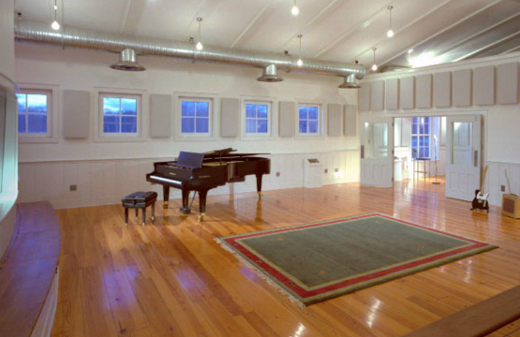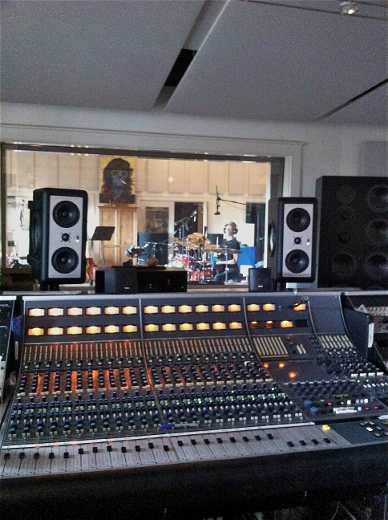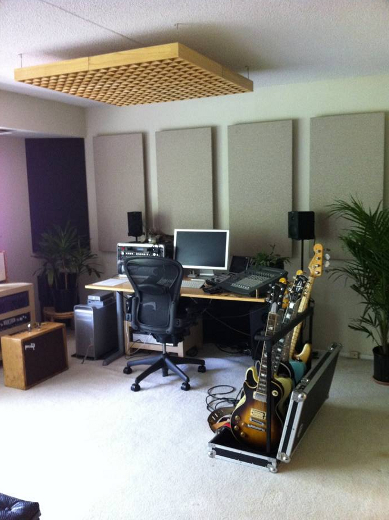Big Sounds for Small Speakers — Tracking for TV with Rich Tozzoli
RIVER VALE, NJ: When sound for picture is what’s needed, one composer the major networks turn to is Rich Tozzoli: GRAMMY-nominated producer, guitarist, mixer, and engineer.
Composing tracks for Fox NFL, and shows like “Pawn Stars, “Duck Dynasty,” and “American Guns”, the hook that often gets Tozzoli the gig is his intensive process for creating sound that “jumps out” of the TV speakers. His path to making viewers feel that wide dynamic range often starts with the real thing, recording drums and guitars in large live room-equipped studios like the Clubhouse in Rhinebeck, NY.

The large live room at the Clubhouse in Rhinebeck, NY gives composer Rich Tozzoli an edge for TV assignments.
Tozzoli’s expertise in playing guitar and mixing in 5.1 surround sound add to his versatility, allowing him to create original music and sound design for a wide variety of media and genres.
Recently Tozzoli welcomed SonicScoop into his River Vale, NJ home studio where he takes his live room recordings, then turns them into tracks for TV that he mixes and produces like a mini-record. We didn’t hesitate to talk to Tozzoli about how to achieve a pumping sound that leaps out of the speakers and launches viewers into their favorite shows.
How would you characterize the kind of sound you go for when you’re producing music for TV?
That depends on what the shows are asking for. But I think of these tracks as minute-and-a-half records. I put the same amount of production into these pieces of music as I do any artist that I mix for. Overall though, I go for the sound of big drums, big guitars and big bass. I like ‘em big!
Why is getting that type of sound important to you – how does it not only make you stand out as a composer, but also help benefit the production and viewer experience?
Well, I like to think my tracks “jump out” of the small speakers on TV. I’ve taken all the production experience of working with great guitarists such as Al DiMeola and Ace Frehley, etc… and applied it to my own tracks. I do a lot of tracks with live drummers in good rooms, and I use quite a bit of room mics and compression to make them pump.
Isn’t it a lot more labor-intensive to cut tracks with real drummers than to just use samples?
Sometimes – yes. But it’s a lot more realistic and that definitely translates onscreen. Plus, it’s a lot more fun. You gotta have fun doing this, or else pick another career!
What is the creative brief you get from your clients, on shows such as “Fox NFL,” “Duck Dynasty,” and “Pawn Stars” – what kind of music, sound, or feel, would you say they’re looking for?
Again, that depends. Each show has its own sonic signature that you have to adjust to. The open D-tuned Resonator slide tracks for “Duck Dynasty” wont fly on “Fox NFL” – but the nasty, edgy drop D Les Paul rock tunes for NFL wont fly on Duck Dynasty and so on. I also do a lot of scientific music and crime drama – they have their market and sonic flavor.
How does recording at studios such as the Clubhouse help you to achieve your sonic objectives?
Well, as far as big drums and big guitars, you cant get them any other way than to let them breathe in a great live room. I’m lucky to have a room like the Clubhouse, as well as a few drummers that have nice-sounding rooms of their own. It’s a team effort.
I do use a lot of room mics, and when working with folks like Paul Antonell at the Clubhouse, I rely on his great ribbon mic collection– which can take my style of hard compression without getting edgy. So, I choose to often record in a good live room with excellent gear.
I’m careful about my signal path – all the way from having good, well-intonated guitars — with fresh strings — to the cables to the amps, mics, preamps, converters and on up to the mix stage. I have a nice little collection of vintage amps that sound great. I pay attention to every detail, and try to let nothing slide. Also, I’m lucky enough to work with great drummers – from Ray Levier and Shawn Pelton to Vincent Miraglia – they help make all the difference.
This may sound obvious, but why does the sound of a room matter so much in recording for TV?
Well, that’s actually just a personal production preference of mine. I use rooms to add a dimensional aspect to the tracks, which really does shine through – even when the track is sitting behind dialog.
Lucky for me, the editors cut to a lot of stings that I add, so its often just my music and video. That’s when you really can hear the room sounds on drums and guitars – but more on the drums.
Does tracking for TV allow for creativity? Where do you draw inspiration for your sounds from?
Oh yes, I love it. The reason is, I can go from wicked hard rock to creepy orchestrated sound beds to Cajun music all in one day. I love that. I don’t like to do too much of one thing – I get bored fast. This lets me express all my different styles.
Inspiration comes from many places – but primarily from the different instruments I play. For example, the baritone guitar will have its own sounds, as will my resonator, or a mandolin, or a good Guild 12-string acoustic. That also applies to different tunings that I use, and with electrics – to different amps. Plugging into an old ’60’s Gibson Falcon or Magnatone with a good Tele or Les Paul will inspire its own direction. Lucky for me, many of the shows I compose for are guitar-centric.
But I also do sound design, and study orchestration and keyboards – you have to be versatile. I love composing string music as much as anything else.
What are some important things to take into consideration when producing music for TV, as opposed to other media? How does your experience mixing for surround 5.1 affect your engineering?
You have to be careful with the bottom – as some of it won’t get through on a show. Mixing for records and mixing for TV are two different but related things. For example, I’ll make kicks “tickier” on TV tracks. I’ll make the top of the drums a bit brighter than a record too.
Funny thing is, many people actually hear TV better than they hear records now! Like many people, I have good stereo speakers on my big screen TV, or I listen through the 5.1 system – which sounds great. Whereas most people now listen to music on iBuds smaller than my fingernails – which is sad but true. But hey, I’m happy, they get to hear the room sounds on the drums and guitars!
As for my 5.1 experiences, I’m lucky enough to still mix 5.1 projects – but as far as applying it to TV, I simply think of the depth in my stereo mixes as having rear speakers. I do look forward to the day where I can deliver my tracks in 5.1, since so many shows are in surround. But also, many of them just up mix from stereo to 5.1 with a plug in that “auto-creates” a surround mix, which is sad. I want to deliver the tracks in full surround.
What is the creation process like for you in your studio? What are the pieces of software/hardware equipment that you find particularly inspiring when recording?
The creation process just happens – luckily. I can simply put my mind to a track and make it happen. Sometimes, I will stick to one style for a few days and spit out as much as I can. For example, I’ll study some country guitar and then output a bunch of tracks that fit certain shows that use that sound. Then I’ll switch to metal and head in that direction for a time – with my old Kramer. Fox NFL and “American Guns” uses a lot of my heavy tracks with good old Floyd-Rose Tremolo dive bombs. It’s fun to watch football on Sunday and hear that guitar. I still get a kick out of it.
But I also use Pro Tools as an instrument – mangling and manipulating tracks with a wide variety of plugins. I often turn to Reason as well, using the Combinator to create lush sonic beds or crazy synths. I’ve lately been using some outboard hardware synths too, such as the Novation MiniNova. Or I’ll have guys like New York-based Bruce MacPherson play on my tracks. He’s an amazing keyboardist with an immense synth collection. There’s nothing like twisting a real Filter knob! Again, it’s great to get other people’s take on tracks – as it makes for a more collaborative effort.
Aside of the instruments and amps, I truly am inspired by a great variety of plugins. I can use an EP -34 Echo, Echoboy or a 201 Space Echo on guitars, Distressors and old 1176’s on drums, and things like the SSL 4K compressor, Massive Passive and Oxford Inflator on the master bus to pump the tracks up like a record.
Pro Tools really is an instrument on its own – it’s invaluable to me for scoring to picture, mixing, and recording at a good pace.
So what’s next — do you have any special projects on your plate right now?
Well, I just finished co-writing an upcoming ESPN 1-hour documentary show with Scott E. Moore, another live scientific score for TED talk, and am now doing tracks for a wide variety of shows on the Weather Channel, A&E, Nat Geo and Fox. This week I’ve been in piano/synth mode scoring some crime dramas. But tomorrow, it’s back to the vintage amps. Its all fun, and I get to play with all my toys every day.
Sounds like fun to us! And it also seems like you get a lot of creative inspiration from your surroundings.
I do draw creativity from living in the “country” with a lot of natural sunlight in my room and the ability to go for walks along the Hudson River by Piermont and Nyack.
But I live just outside of New York City and I love the energy buzz I get when working in town. There’s no place else like it in the world – literally.
— Jacqueline Smiley
Please note: When you buy products through links on this page, we may earn an affiliate commission.








